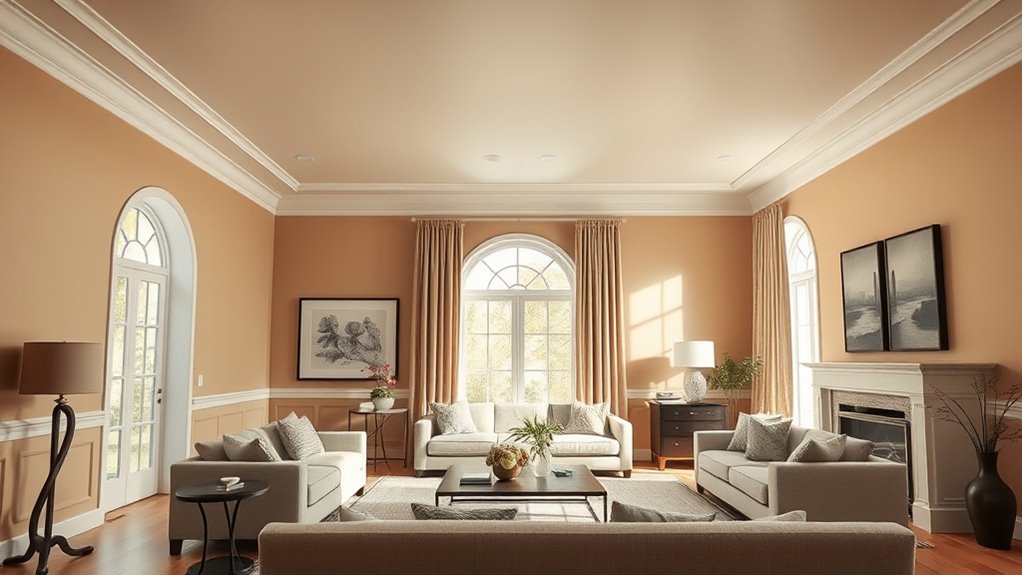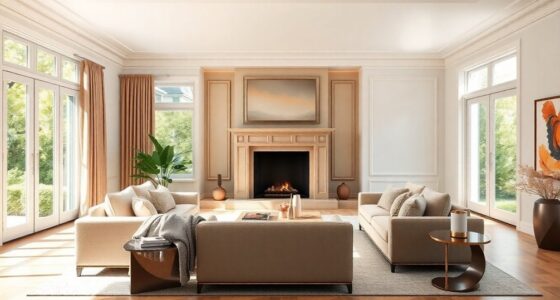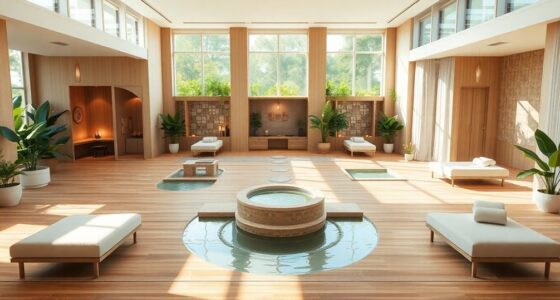To fake high ceilings with paint, choose light, neutral colors like whites or creams to make the space feel taller. Use vertical stripes or elongated patterns to draw the eye upward, and apply a slightly lighter shade on the ceiling for a seamless look. Adding horizontal lines at mid-wall height can also create depth and width. Highlight architectural details with strategic color contrasts, and finish with reflective, glossy paints to enhance brightness. Keep exploring these tips to master the illusion.
Key Takeaways
- Use light, neutral wall and ceiling colors, with the ceiling shades a few tones lighter than the walls, to create an upward flow.
- Incorporate vertical stripes or elongated murals to draw the eye upward and enhance perceived ceiling height.
- Add horizontal lines or contrasting bands at mid-wall to give a sense of depth and make ceilings appear taller.
- Apply reflective, glossy finishes on walls and ceilings to bounce light and visually expand the space.
- Highlight architectural features with darker shades or color accents to emphasize vertical elements and elongate the room.
Choose the Right Color Palette
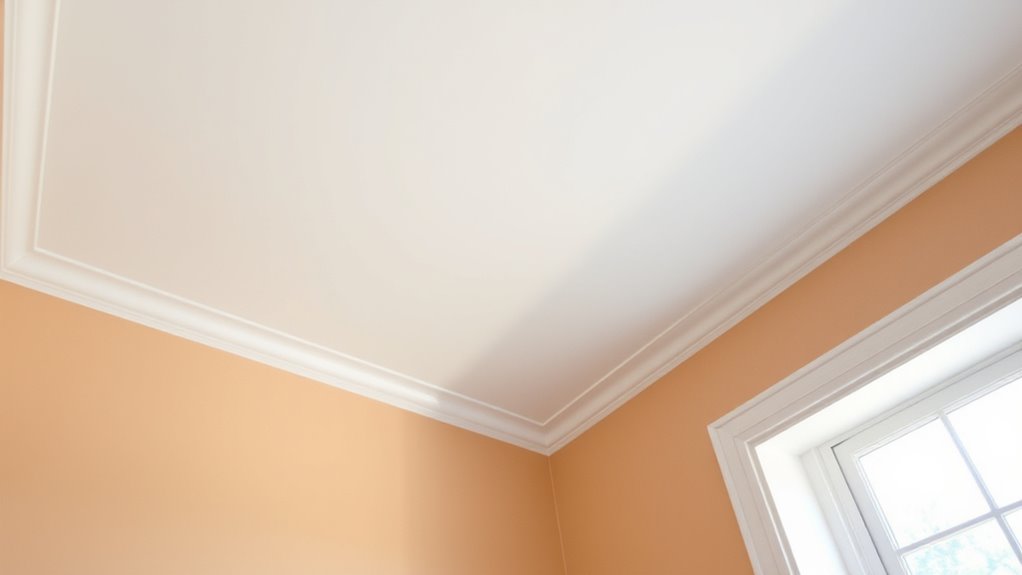
To create the illusion of higher ceilings, choosing the right color palette is essential. Opt for light, neutral shades like soft whites, creams, or pale grays, which reflect more light and make the space appear more open. Achieving good color harmony across walls, ceiling, and trim ensures a seamless flow that draws the eye upward. Consider the paint textures as well—matte or eggshell finishes reduce glare and add depth, enhancing the sense of spaciousness. Avoid dark or heavy colors near the ceiling, as they can make the room feel lower. Instead, use subtle tonal variations to create a cohesive look that elongates the vertical space visually. Utilizing color harmony principles can further improve the visual flow and make ceilings seem higher. With the right color choices, you can make your ceilings feel higher without a single renovation.
Use Vertical Stripes or Patterns
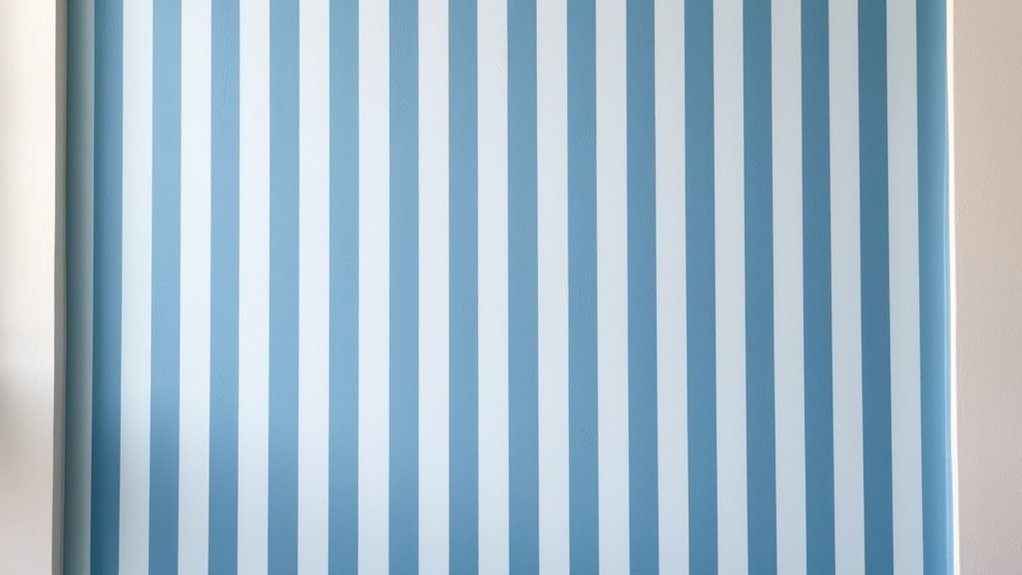
Vertical stripes and patterns can draw the eye upward, making your ceilings feel higher. Try bold stripes for a striking effect, or vary stripe widths to add visual interest. Incorporating patterned designs can also enhance the illusion of height without overwhelming the space. Using diverse designs and creative patterns can further amplify this effect, transforming your room’s perceived height.
Opt for Bold Stripes
Opting for bold vertical stripes or patterns can instantly draw the eye upward, creating the illusion of higher ceilings. To maximize this effect, consider using textured finishes that add depth and interest to your walls, making the stripes stand out even more. Incorporate wide, bold stripes in contrasting colors to emphasize verticality. You can also enhance the illusion by adding ceiling murals or painted patterns at the top of the wall to guide the viewer’s gaze upward. Keep the stripes clean and crisp for a modern look, or add textured finishes for a more dramatic impact. This approach not only elongates your space visually but also adds personality and style, making your ceilings feel taller without any structural changes. Additionally, being aware of support hours and peak visiting times can help you plan your painting project during quieter periods for a more relaxed experience.
Vary Stripe Widths
Varying stripe widths adds visual interest and enhances the illusion of height in your space. By mixing narrow and wide stripes, you create a dynamic pattern contrast that draws the eye upward, making the ceiling feel taller. Using stripe variety prevents the design from appearing monotonous, adding depth and movement to your walls. This technique works best with vertical stripes, as they naturally guide your gaze upward. Keep the pattern contrast subtle yet deliberate—avoid overly uniform lines or overly bold differences that can disrupt the illusion. When choosing your stripe widths, consider the overall scale of your room and ceiling height. Properly executed, this approach makes your space feel more expansive without the need for structural changes. Additionally, incorporating decorative elements like moldings or contrasting paint accents can further enhance the ceiling height illusion.
Incorporate Patterned Designs
Incorporating patterned designs like vertical stripes or other elongated patterns can effectively enhance the illusion of height in your room. These designs draw the eye upward, making ceilings feel taller. To maximize this effect, consider adding wall textures or subtle ceiling murals that extend vertically. You can also experiment with different pattern scales to create visual interest and depth. Using bold vertical stripes creates a striking focal point, while softer, narrow patterns subtly stretch the space. Incorporate these elements strategically to avoid overwhelming the room. Remember, the goal is to direct attention upward and give the impression of a higher ceiling. For a cohesive look, coordinate your furniture and decor to complement the patterns and maintain a balanced aesthetic. With the right combination of patterns and textures, your room will feel more spacious and airy.
Apply a Lighter Shade on the Ceiling
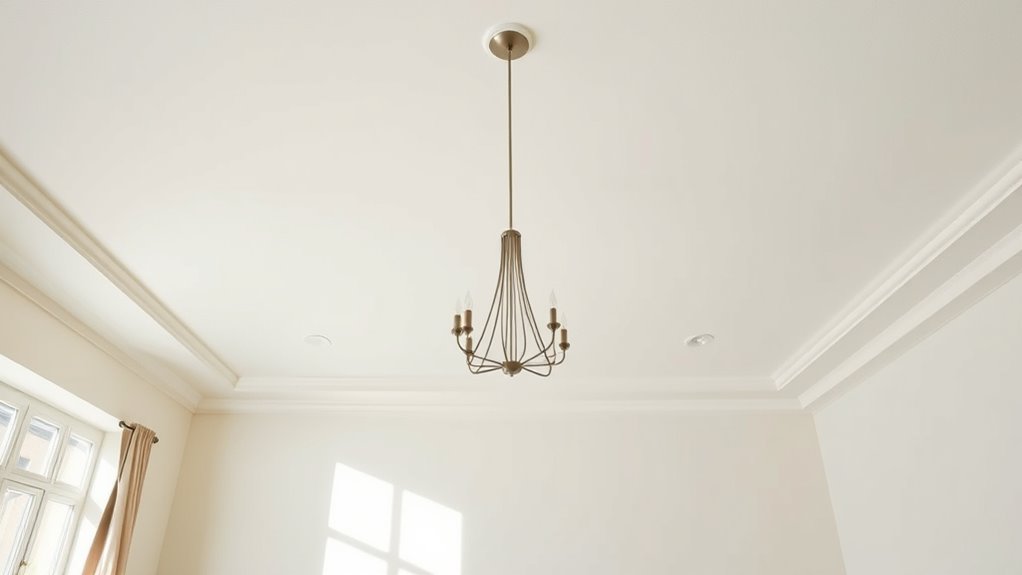
To create the illusion of higher ceilings, applying a lighter shade of paint on the ceiling is a simple yet effective strategy. A lighter color increases the color contrast between the ceiling and walls, drawing the eye upward and making the space feel taller. Choose a shade that’s just a few tones lighter than your wall color for a seamless look. When working with textured ceilings, opt for a matte or flat finish to minimize shadows caused by ceiling texture, enhancing the sense of height. Keep in mind that a consistent, clean application helps avoid visual clutter, maintaining a sleek, airy feel. This subtle change can dramatically enhance your room’s perceived height without major renovations. Additionally, understanding visual perception can help you select the most effective color shades to maximize the illusion of height.
Incorporate Horizontal Lines for Depth

Adding horizontal lines to your walls can create a sense of depth and width, making your ceiling appear higher. This technique uses horizontal illusions to trick the eye into perceiving more space. To maximize room expansion, consider these tips:
- Paint bold, thick horizontal stripes at mid-wall height to draw the eye outward.
- Use contrasting colors for the lines and background to enhance the illusion.
- Incorporate subtle, continuous lines to guide the eye across the room, emphasizing width.
- Incorporating lighting techniques can further amplify the visual effect and enhance the perceived height of your ceiling.
These strategies help create an optical illusion that visually raises your ceiling and broadens your space. Horizontal lines are a simple yet effective way to manipulate perception, making your room feel more open without structural changes. Use them thoughtfully to achieve a spacious, airy atmosphere.
Highlight Architectural Features With Paint
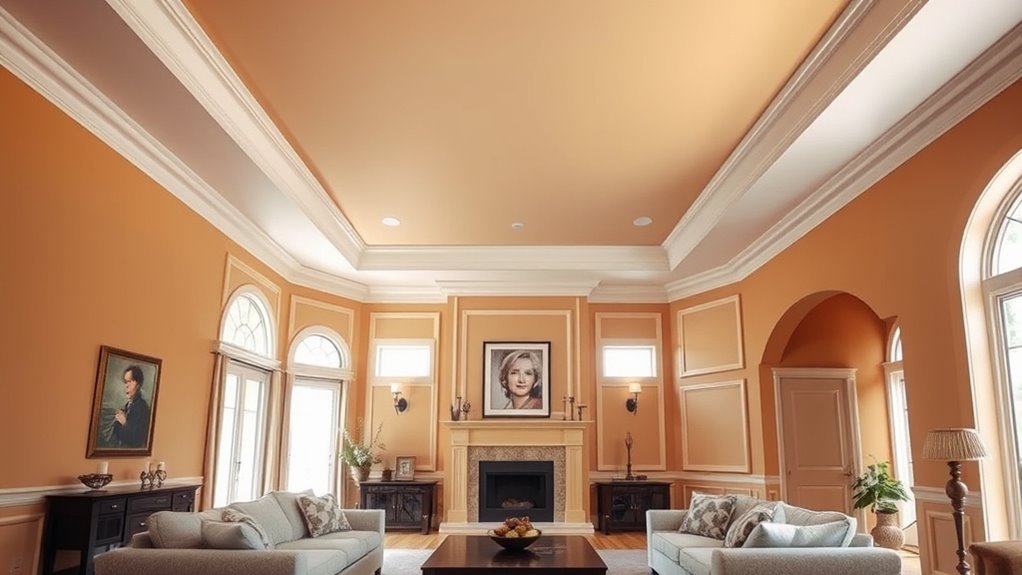
By highlighting your room’s architectural features with paint, you can draw attention to elements that naturally elevate the space’s perceived height. Use mural accents to emphasize moldings, columns, or built-ins, creating focal points that add visual interest and depth. Incorporate color blocking around doorways or along trim to outline architectural details, making them stand out. For example, a darker shade on a fireplace surround or a contrasting color on crown molding can draw the eye upward. These techniques create a layered effect, giving your room a sense of height without major renovations. When applied thoughtfully, mural accents and strategic color blocking transform ordinary features into eye-catching design elements that subtly enhance verticality. This approach makes your ceilings feel higher and your space more open. Additionally, understanding home design principles can help you choose the best colors and techniques to maximize the illusion of height.
Use Glossy or Semi-Gloss Finishes
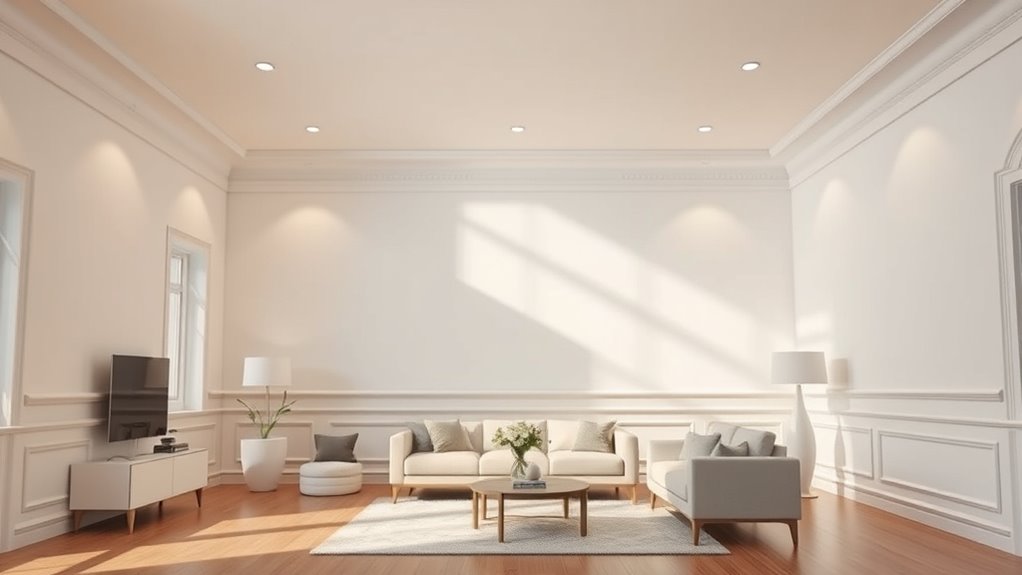
Using glossy or semi-gloss finishes can reflect more light, making your ceiling appear higher. This subtle shine enhances the perception of space and adds depth to the room. It’s a simple way to create the illusion of a more open, airy ceiling without major renovations. Additionally, choosing the right paint finishes can contribute to a more spacious feel in your room.
Reflects Light Effectively
Have you considered how a glossy or semi-gloss finish can transform your ceiling? These finishes reflect light effectively, creating brighter, more dynamic spaces. By enhancing lighting effects, you make your ceiling appear higher and more expansive. They also accentuate ceiling textures, highlighting details that add depth and interest. To maximize this impact, consider:
- Using glossy paint in rooms with ample natural or artificial light
- Pairing reflective finishes with smooth ceiling textures for a sleek look
- Applying semi-gloss in areas where you want subtle light bounce without overwhelming brightness
- Incorporating light reflection principles to optimize the visual effect and enhance the illusion of height.
This approach boosts light reflection, making the ceiling feel taller and the room more open. The right finish can truly redefine your space’s perception, giving the illusion of greater height with minimal effort.
Enhances Ceiling Height Perception
Applying glossy or semi-gloss finishes to your ceiling amplifies the perception of height in your space. These finishes reflect light better, making the ceiling feel higher and more expansive. To maximize this effect, consider incorporating smooth wall textures that don’t compete with the ceiling’s shine. Additionally, strategic placement of ceiling fixtures, like recessed or pendant lights, enhances the reflective quality. Here’s a quick comparison:
| Finish Type | Wall Texture | Ceiling Fixtures |
|---|---|---|
| Glossy | Smooth, minimal textures | Bright, sleek fixtures |
| Semi-Gloss | Slight textured walls | Subtle, reflective lighting |
| Matte | Textured or patterned walls | Less reflective fixtures |
| Satin | Medium wall textures | Modern, understated fixtures |
| Eggshell | Slightly textured walls | Soft, diffused lighting |
Choose glossy or semi-gloss finishes for a brighter, taller-looking ceiling.
Adds Visual Depth
Glossy and semi-gloss finishes can create a striking sense of depth in your ceiling by reflecting light and adding dimensionality. This finish enhances lighting effects, making your space feel more expansive and dynamic. When you use these sheens, the way light interacts with the ceiling draws the eye upward, creating an illusion of height. To maximize this effect, consider strategic furniture placement that directs attention toward the ceiling’s reflective surface. Incorporate these tips:
- Use glossy paint in areas with natural or artificial light sources for maximum reflection
- Position furniture to guide the eye upward, emphasizing the depth created by the finish
- Combine with lighter wall colors to enhance brightness and spatial perception
These techniques work together to give your room a more open, airy feel.
Strategic Placement of Walls and Corners
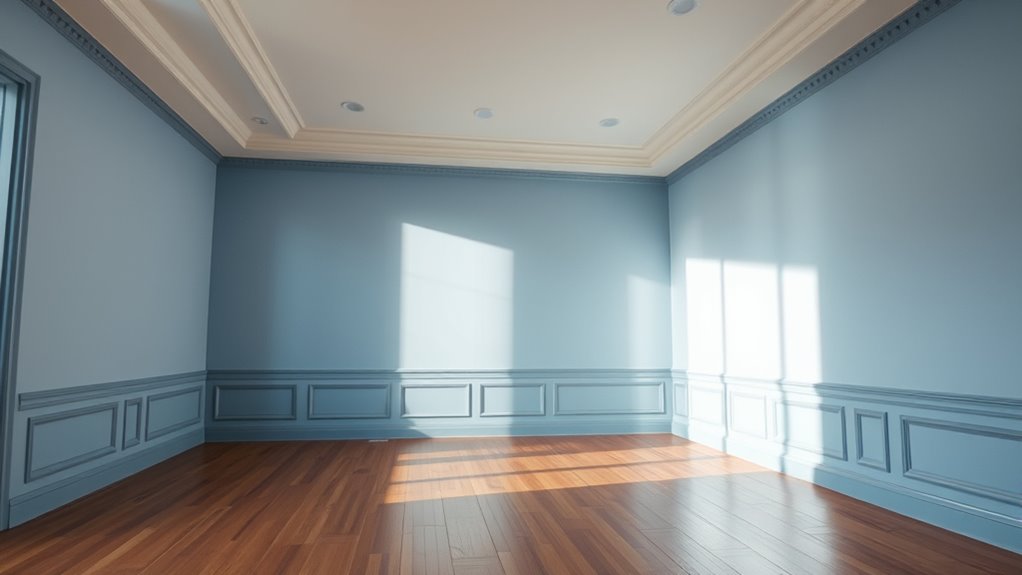
Strategic placement of walls and corners can dramatically influence the perception of ceiling height in a room. By carefully planning wall placement, you can create illusions that draw the eye upward. Using corner tricks, such as painting the corners in a darker shade or adding vertical lines, emphasizes height. Consider the following techniques:
| Technique | Effect |
|---|---|
| Extending vertical lines | Creates a sense of taller space |
| Positioning walls closer | Shortens the perceived ceiling height |
| Highlighting corners | Draws attention upward and elongates the room |
These strategies manipulate how your eyes interpret space, making ceilings appear higher. Proper wall placement combined with smart corner tricks is a simple yet powerful way to enhance your room’s proportions without structural changes.
Frequently Asked Questions
Can I Fake High Ceilings in Small Rooms Effectively?
You can effectively fake high ceilings in small rooms by using strategic paint techniques. Focus on creating a sense of increased vertical space through color psychology—lighter shades make ceilings appear higher, while darker hues can add coziness. Employing visual perception tricks, like painting the ceiling a lighter color than the walls or using horizontal stripes, can make your ceilings seem taller, enhancing the room’s overall openness without actual height.
How Does Lighting Impact the Illusion of Height?
Lighting tricks markedly enhance the illusion of height in your space. Use vertical lighting, like wall sconces or upward-facing lamps, to draw the eye upward. Incorporate color contrast with lighter shades on the ceiling and darker walls to create a sense of depth. Proper lighting emphasizes these contrasts, making your ceilings appear higher. By focusing on strategic lighting and color contrast, you can successfully fake high ceilings and make your room feel more spacious.
Are There Specific Paint Brands Best for This Technique?
You’ll find that choosing the right paint brands makes a difference, especially those offering matte or eggshell sheens, which help create depth. For the illusion of height, pick paints with high color contrast—like a darker ceiling and lighter walls. Brands like Benjamin Moore, Sherwin-Williams, and Behr offer excellent options for quality paint with ideal sheens and vibrant colors, making your ceiling appear higher and more spacious.
Will This Method Work With Textured or Patterned Walls?
Thinking about textured or patterned walls is like trying to fit a square peg in a round hole. This method can work, but you’ll need to contemplate wall texture and paint sheen carefully. A smoother finish with matte or eggshell sheen helps create the illusion of height, while heavy textures might disrupt the visual trick. Adjust your technique accordingly, and you’ll still achieve a room that feels more spacious.
How Long Do the Paint Effects Last Before Needing Touch-Ups?
You’ll find that the paint effects can last several years with proper application, but paint durability varies based on factors like wall condition and exposure. Over time, you might notice the need for touch-ups to maintain the illusion of height. Generally, you’ll need to do touch-up frequency every few years, especially in high-traffic areas. Regular cleaning and avoiding harsh chemicals can help preserve the paint’s appearance longer.
Conclusion
By subtly playing with colors and patterns, you can create the illusion of soaring ceilings without lifting a finger. Embrace the art of visual trickery to open up your space and add a touch of grandeur. With a few clever paint choices, you’ll transform your room into a place that feels more expansive and inviting—like a whisper of the sky just beyond reach. Sometimes, a simple illusion can truly elevate your entire home.
